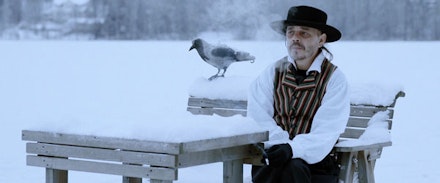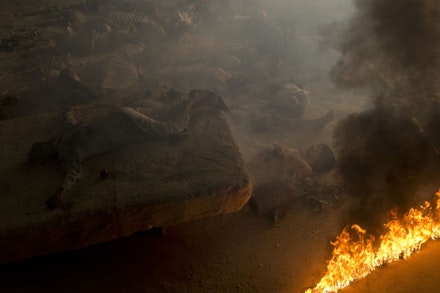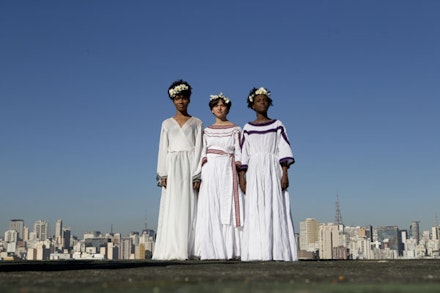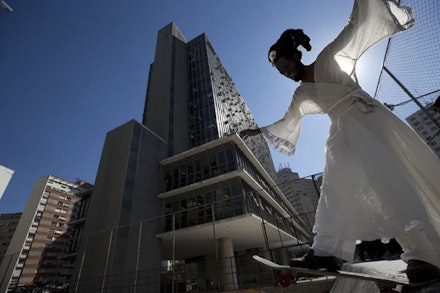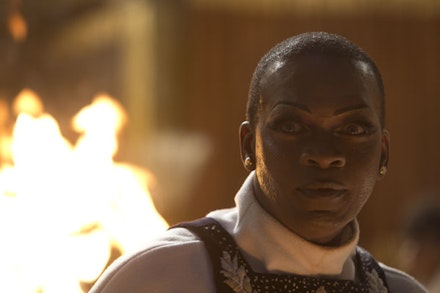Art In Conversation
YAEL BARTANA with Sara Roffino
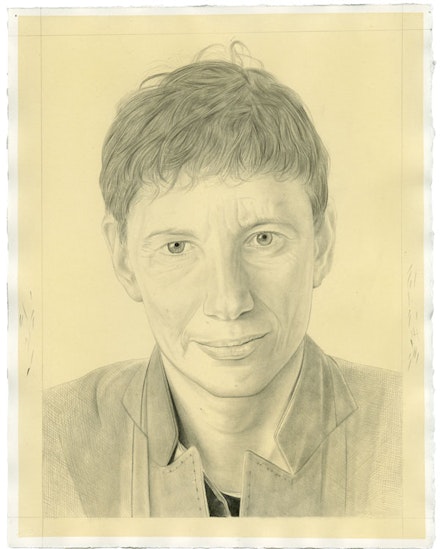
Yael Bartana’s current exhibition at Petzel Gallery presents two recent films: True Finn (2014) and Inferno (2013). The former, an examination of the possibilities and limitations of identity in Finland, takes its title from the English translation of Perussuomalaiset, the right-wing populist, nationalist political party which has been the largest Parliamentary opposition party in Finland since 2011. Bartana, who is Israeli and lives between Berlin, Amsterdam, and Tel Aviv, takes the recent completion of a replica of Solomon’s Temple in São Paulo—built as the new home for the Universal Church of the Kingdom of God, costing approximately $300 million, and with space for 10,000 parishioners—as her point of departure for Inferno. Just before the exhibition opened to the public Bartana met with Rail managing editor Sara Roffino to discuss rising nationalism, utopic visions, and Avinu Malkeinu.
Sara Roffino (Rail): Yesterday’s tragedy in Paris was a really extreme example of what can happen as a result of something an artist makes and then puts out in the world. Your work, which deals very directly with nationalism, statehood, and political and social identity, often elicits strong reactions so I thought we could start by talking about risk. How do you think about risk in the sense of the risk of reaction, violent or not? And how do you think of it in the subtler but more permeable way that artists always risk their work being misunderstood?
Yael Bartana: Yeah, this is a very sad example of that risk. The reaction was outstanding of any proportion. It tells a lot about how much we do not and cannot consider—there is a huge gap between the thinking of radical Islam and the West.
I do put myself at risk with my work, but maybe because it’s not in the mass media it’s a bit safer. I very often receive quite strong negative reactions. With the trilogy And Europe Will Be Stunned (2007 – 11) I was a bit scared. Sometimes I would think: my god, maybe I will get assassinated for touching the flag or national flags, and maybe allowing myself too much. At the same time though I see the practice of art as the possibility for exactly that—to allow one person to dare more. People react in really unexpected ways. With Inferno people from the church saw the film and they were mostly disturbed by the fact that I worked with a gay person, they weren’t so concerned about the destruction of the temple. [Laughter.] It tells a lot about the emphasis of their beliefs, but you know, all these ideas of the messiah, or messianic thinking, it’s all about catastrophes—it’s all about apocalyptic kinds of moments, so maybe somehow Inferno is actually promoting their visions.
I think maybe what the art world needs—and there are some people who are doing this, actually this week there is a congress in Berlin called Artist Organization International—is to think of a possibility for a kind of union or a situation where there is an organization for artists who have movements. Support and solidarity should be promoted.
Rail: Do you align yourself politically? Or do you feel that as an artist there’s an exemption, or that your role is different?
Bartana: I think my role is very different. I practice in contact with politics, but I try to suggest something different. It is political, whatever I do is very political, but I’m trying not to limit myself. Politics are very much attached to a very specific agenda. I think my works are quite ambivalent and therefore you can have leftist people loving the work and right-wing people loving the work—that’s actually what I encounter because they both see that it represents themselves in some way. I am interested in the art of the impressible.
Rail: You’re not proposing an agenda, you’re not saying these are my beliefs or these are what your beliefs should be. You’re really using politics as a medium to look at these other parts of living together in the world. Does that feel accurate to you?
Bartana: I think I look into what society provides and how we can question it, and how we can undermine and how we can propose different kinds of readings and spheres and open the imagination to new possibilities. That’s what every artist begins with and proposes, but I’m very connected to the reality and always very much motivated by it. When I first heard about the nationalistic, populist True Finn party, I was inspired to ask: What is a true Finn? Who is a true Finn? And when I heard about this mega-church in Brazil, I wanted to react; I want to pull these new strings and think about the future of such a project. In the past I would call myself an amateur anthropologist, but I’m not really—I’m still an artist.
Rail: With True Finn you brought eight strangers living in Finland to a remote house and had them do different activities together exploring what it means to be Finnish. For Inferno you made a highly dramatic fictional film centered on the non-fictional replica of the first temple constructed in São Paulo last year. Built by the Universal Church of the Kingdom of God, a neo-Pentecostal evangelical church, the building’s inauguration drew nearly 10,000 people, including the president of Brazil. Were these projects the first time you were working in a culture that you didn’t have a personal history or relationship with?
Bartana: Actually in 2004 I was commissioned by the Liverpool Biennial to make a new piece and I tried to investigate Liverpool through horseracing. It was one of my early films, titled You Could Be Lucky. I was focused on the crowd because in Liverpool these races are a time when the working-class people really dress up and change their appearance. It came out as a very funny film, quite funny.
Rail: How are the stakes different when you’re working with Poland, Israel, or Jewish identity than when you’re working in Finland or Liverpool or Brazil, where you don’t have a personal access point?
Bartana: Regardless of where I am working, I am always interested in the questions of identity politics and political imagination and how you can expand that and allow for different possibilities. With True Finn, I worked very closely with two collaborators, producer Paula Topilla and scholar Illa Ben Porat and I wanted to expand and update the idea of what it means to be a Finn by creating a platform for the people involved with the project to express their own identity. So it wasn’t in my hands in a way—it was only in my hands to create a structure, but I had absolutely no idea how it would look in the end.
Rail: When we’re talking about our own culture it’s easier to be critical than when we’re talking about other people. Do you feel more of a responsibility to be neutral when you’re working outside of your own history or identity? How do you navigate that difference?
Bartana: It’s very different when my own history is involved because it comes from many years of exploring the issues and questions and my personal biography. For several years before going to Poland I was focused on Israel and Palestine. I already had a body of work dealing with the issues involved. I had already developed my critical approach. I had a mission to expand the Israel/Palestine conflict back to its origin, back to Europe. Poland, of course, has a very specific history with Jews, but I saw it also as a laboratory of how to write a new narrative. I wanted to imagine a new page in the history book and to explore the social change that art can bring. Maybe I didn’t actually change anything, but at least it opened something up. I can tell after six years of working there that it did open up a new dimension, at least among a number of people. Maybe it isn’t a national change, but more Israelis are now interested in going to work in Poland. It’s kind of the fashion to work in Poland right now. I feel I was a part of Polish culture and art. In a way they were really waiting for the Jew to come and open the discussion. I was maybe fitting into some kind of empty spot. [In 2011, Bartana was the first non-Pole to represent Poland in the Venice Biennial.]
In Finland, I was totally foreign. I had a Finnish partner a long time ago, but I really didn’t know much about the country. When I got there and started to meet people, and find out about Finland, I slowly developed the project with the help of many people. I first wanted to meet activists. It was during the time of Occupy and everyone was occupying the squares and so I met an activist because I wanted to know what the discourse was about and where it was coming from. I created a think tank for which I invited the curator of the festival, as well as Finnish and Israeli scholars. The topic wasn’t something I had specifically thought about, but the ideas it concerns are very close to my heart.
Rail: And was that a similar experience in Brazil? How closely were you working with people in São Paulo?
Bartana: In São Paulo I worked with a curator named Benjamin Seroussi very closely—he worked for a Jewish cultural center. He and an Israeli curator, Eyal Danon, invited me to be a part of a small project he was working on about new religious movements in Brazil. Many evangelists were coming to his center to study Hebrew to be able to read the Old Testament and suddenly all different Jewish symbols began appearing—you know, like the arc and the menorah, and he wanted to know more about what it was all about. I worked with him very, very closely.
Rail: The Universal Church of the Kingdom of God, the church that built the replica of Solomon’s temple, has been involved in several different scandals, including a federal Brazilian report stating that they had been spreading religious intolerance. Was this also a part of your interest in the church? Is it an exploitation of Israel and of Jewish history?
Bartana: I don’t know if they’re exploiting, but I would say very much that they are manipulating their own people. It’s an extremely manipulative church, but I didn’t want to criticize it because it’s not the only manipulative church or religious institute. I consciously didn’t want to criticize the bishop. From the very beginning my protagonist was the temple itself, the building. With Israel I feel like I can criticize, I can do whatever, I’m from there, you can put me in jail if you want. But here I was focusing on the temple, on the very fact that the Bishop, Edir Macedo, is trying to create a sort of new Jerusalem. My main focus was trying to figure out what this guy is doing. He’s borrowing elements from Jewish theology and trying to create a story, a narrative. He’s using other, let’s say, tragedy narratives to match tragedies of the people of Brazil—very poor people who have had their own exodus from the northeast parts of Brazil to São Paulo.
Rail: With Inferno and with True Finn, it feels like you were more interested in the present than looking to the past, as opposed to And Europe Will Be Stunned. Has there been a shift in terms of how you’re thinking about time? You’ve spoken before about the importance of acknowledging the present and I’m curious about how you’re thinking about the present versus the past right now. True Finn is very much about negotiating new dynamics within Finland and Europe, and Inferno is similarly about a church that was constructed just last year.
Bartana: I see True Finn more as a laboratory of what’s happening in Europe in general right now. The recent era of migration has created a fundamentalist and reactionary voice against the organization of the West. I wanted to look into this whole story of the nation-state from the 19th century, which is currently readjusting itself. I’m interested in the effects of hegemony—the exclusion of the small voices that are trying to fight for their rights or identity. They want to be acknowledged. And in regard to Inferno, I am completely fascinated by this whole current affair of religions crossing geographical borders.
Rail: Do you feel that you’ve reconciled something you were thinking about historically and now you’re starting to look to the future, to the present?
Bartana: The history of the Finnish nation is there in True Finn in the archival cuts. The creation of the nation-state, the Finnish nation-state, is represented by those archival films, so the history is there. And I include the traditional clothing, which is obviously not something people still wear. But yeah, I wanted to do a contemporary film from a very specific perspective, which is not in the mainstream, to sort of update what is Finnish identity today and to show, for example, that a Sami person would never agree to those terms.
Rail: Yeah, I love the costumes and the artifice of it all, the dramatization of it was sort of funny to watch from an American perspective because, at least for me, these were conversations I was forced to have as a kid. Where is your family from? Are you Jewish or Italian and blah blah blah.
Bartana: Don’t forget where you are from! [Laughter.]
Rail: True Finn was commissioned by the IHME Contemporary Art Festival, based in Finland, and it was available on Finnish public television through the end of 2014. In order to make the piece, you held an open call and then selected eight people (of varying backgrounds and political affiliations, but all of whom live in Finland) who you then brought to live together in the countryside for a week. You staged different activities for them—like making a new Finnish flag, writing a new national anthem, all this very gimmicky nationalist stuff—and nobody resisted or even questioned it. You mentioned in a previous interview that you were surprised about that, and I was too, partly because those activities are like children’s activities.
Bartana: I was not surprised by the fact that people wanted to join such a project, but I was surprised by the fact that no one resisted or questioned the tasks. Nobody asked why we need all these symbols or if there is an alternative. I was really hoping somebody would resist it and ask, Why do we need this stuff? Why do we actually need the nation-state? Why do we need to do all these exercises? But they really obeyed me, maybe they felt very committed to me. On some level the anarchist kind of fulfilled that role, saying, “I don’t care about politics,” and, “I am a nihilist. What do you want from me?”
Rail: Right, yeah. And the young woman who says, “Fuck you, I’m not voting.”
Bartana: I love that, yeah.
Rail: And it’s interesting that Mustafe, who’s from Somalia and Tiina, the Roma woman, are the most engaged in the activities. Or was it edited to seem that way?
Bartana: No, they were like that.
Rail: Why, do you think?
Bartana: It was very important for them to be included in the project and it’s really real, it’s very sincere. It’s an obvious kind of reaction to the situations they were placed in, but they really do want to be recognized as true Finns. If you’re privileged and are not deprived of your rights, there is no doubt about who you are. You don’t have to fight for it, you’re just there. But they have to fight to be recognized.
Rail: And because of the blend of fact and fiction, because there is the fiction to it and because there is the humor of the Somali man wearing traditional Finnish clothing and ice fishing—it allows you to access the ideas. It is not fraught. The humor lets you see it and talk about it.
True Finn made me think about this case that’s been in the news a bit lately. There was this man who went and lived in the woods for 25 years. He didn’t speak to another human being for 25 years. He would steal what he needed to survive from people’s homes and eventually he was caught, and one of the things he said after he was caught was that when he was alone he became irrelevant. He said he lost his identity because he wasn’t in relation to other people. That’s the tension that True Finn explores, that we need the other in order to define the self.
Bartana: Absolutely, that’s the point: you can’t define yourself without the other. Identity is not fixed. I first found out that I’m Jewish when I left Israel because I never thought to look at myself as a Jew. Jewish people are religious people to me. I’m not Jewish. Jewish identity has a unique situation since the establishment of Israel. Until then it was only ethnic and religious and now it is also national.
Rail: And for me so much of it is because I have such conflict with Israel and I don’t want to be a part of that.
Bartana: What kind of Jew are you? I am joking—
Rail: I don’t practice, I don’t do anything, and part of that is because it’s all sort of lumped together in my mind as one thing that I don’t really want to support. But then, when I was watching True Finn in the gallery, I heard “Avinu Malkeinu” from the other room and it was sort of like the smell of my grandmother’s perfume, or just something that I knew.
Bartana: You feel at home.
Rail: There’s a familiarity.
Bartana: And it feels good or bad?
Rail: It feels good, but I don’t know what that means. Why did you choose “Avinu Malkeinu” (perhaps the most recognizable Jewish song) for Inferno?
Bartana: It’s the most gay song ever. The Barbara Streisand version of it—all the gay men in my life love this version. I don’t understand why. It is a kind of dramaturgic decision. I wanted this moment in the film to be extremely emotional, you know we are in the temple so it is very meaningful, but also disturbing.
Rail: Absolutely.
Bartana: The church borrows all of these Jewish symbols so I took it all the way using all the basic common knowledge of every Jew and the exodus from Israel. I was inspired by Cecile B. DeMille’s Ten Commandments—the overly theatrical, funny approach. To me it is funny, maybe for you it is serious. This was the only sound piece that really worked for this moment in the film. We tried all different music, we even tried “Ave Maria.”
Rail: Which would be such a different experience.
Bartana: It would be identified as super-Catholic. I don’t know if “Avinu Malkeinu” was the right decision, but I think it works. It’s not Barbara Streisand.
Rail: So it was an aesthetic choice rather than—
Bartana: It is beyond kitschy dramatization, very beyond. This wasn’t the case in my earlier works, which were much more intimate. But this was really about the aesthetic decision and the style of the film as it connects to the content. Building this church was a mega-project for this guy, so the film had to be a mega super-production. It wouldn’t work if it was a small film or documentary. I didn’t want to make a documentary about this. I wanted to emphasize the fact that the idea of a construction of a third temple would naturally end in destruction, a pre-enacted tragedy.
Rail: You are very diplomatic in not wanting to say outright that the church is exploiting people, but you do acknowledge that there is a huge element of exploitation.
Bartana: Yes, of course, but the Universal Church of the Kingdom of God is not the only one. There are so many other movements, this is a problem in Judaism as well. And the whole church business—it is a business. Prosperity theology, it’s very capitalistic: if you give more money to the church you become richer and richer. But that is not what this film is about. That would have been a very different approach. The logic of the project is based on historical facts, the destructions of the first and second temples, which are the history of the Diaspora—the central myths of the Jewish people. It’s very metaphoric and symbolic.
Rail: And the end, the fire and the destruction, can you talk about that?
Bartana: Think about Jerusalem, all of its history. It also made sense in terms of the narrative. Sacred places always attract crazy people. The film was about destruction from the very beginning. With the construction of the church, you can already foresee the destruction. That was my point of departure, and from there I built the story.
Rail: And there are a lot of visual references from your childhood. You grew up on a kibbutz and have spent a lot of time looking at ideas of utopia, the failed utopia that people thought Israel could be.
Bartana: It wasn’t a kibbutz, but it was a village with a small-scale agricultural community. There was a lot of disappointment with the utopia—the perfect society was exploding. But I still believe in utopia.
Rail: You’ve spoken before about a utopian vision or utopian language, which I think is really interesting. We know that utopias don’t work, but believing in a utopian vision allows for a nuance where maybe it is actually possible. Israel was utopian in its vision, but ultimately, it has failed. That model of a utopia has never worked, yet we haven’t created a new model. Occupy, that was maybe in the same vein, but we haven’t shifted, haven’t formed a new idea, a new vision, and we know that what exists doesn’t work—
Bartana: We are individualists in the West, we are not a community-based society. It is all about Google; Google is a kind of a utopian vision for a certain kind of people. They’ve created a closed community/society that does all these things. Are they happy? I don’t know. I think I have a strong nostalgia for a sense of community I’ve experienced in the past, but which was nonetheless very exclusive so I wonder how one can be inclusive.
Rail: I don’t know either. But you do believe in a utopia?
Bartana: Of course, if you look at history it doesn’t work. You know the Georges Perec book W, or the Memory of Childhood? It is a pretty amazing book. He is a Holocaust survivor and he describes this society living on an island and basically turning into a totalitarian concentration camp. It is a question that I never know how to answer. I like utopian visions, I like this idea. Aesthetically it is actually best. But how can you be an individual and critical at the same time? I am always thinking about the collective and the individual, and how you can define yourself among the collective, and if you can find yourself in the masses as an individual. I am not very clear, I don’t have a clear answer. It is something that I keep trying to understand. On one hand I am attracted, but on the other hand I see the conseqences.
Rail: And that unresolved thinking comes through very clearly in your work. You aren’t proposing an answer, just examining the possibilities.
Bartana: Yeah, I don’t have an answer. [Laughs]. I try to give space for—
Rail: Imagining?
Bartana: Yeah, to help you imagine the possibilities and find yourself within this kind of project. And not everybody can find it. I understand that it talks to some people, but it doesn’t talk to others. It is not a work where I say, “Wow, aesthetics, beautiful.” It is kind of demanding, it demands that you open up and explore your own identity. You have to work when you see my work, find yourself, and reflect.
Rail: Yes, but it is the aesthetic qualities—
Bartana: That keep people in the room to look at it.


